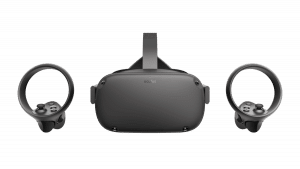
The Oculus Quest is the number one wireless VR headset that does not require a connection to a PC.
Key Features
- Completely wireless; no PC required
- Full 6 degrees of freedom
- Inside-out tracking requires no external base stations
- Access exclusive Oculus Home games
- Second generation Oculus touch controllers
Oculus Quest
Oculus announced the Quest VR headset on April 30, 2019 during the annual F8 Facebook conference. The device was in development as early as 2016 and previewed multiple times by Facebook during that time. It had the code name”Santa Cruz”. Shipments began on May 21st the same year.
The Quest is the company’s wireless VR headset and it has a price tag of $399 USD. Oculus sells the Quest alongside the Oculus Rift S, which is PCVR headset.
The Oculus Quest features a two Pentile OLED displays each with a 1440×1600 resolution. The displays have more pixels horizontally and vertically compared to the Rift S. This helps to reduce the “screen door” effect found on most original VR headsets.
Improvements were also been made to Oculus’ software so that games render more smoothly for the Quest.
The refresh rate on the headset is 72 Hz, which is slightly less than the 80 Hz on the Rift S. This helps the Quest meet its two hour battery minimum.
The headset has a hardware adjustable IPD between 58 mm and 72 mm.
The Quest is completely wireless and does not connect to a PC at all. It contains an integrated Qualcomm Snapdragon 835 CPU chip which is an Android-based processor. This mobile chip is not nearly as powerful as a gaming PC, requiring many cross-play games to be optimized heavily for the Quest.
The headset supports full room-scale virtual reality in a room space up to 25 x 25 feet. This means that the inside-out cameras can track your position in the room up to this distance.
Despite the simpler graphics, the Oculus Quest was the highest selling VR headset of 2019. Its low price barrier to enter the world of virtual reality makes it a top option for consumers.
The Quest contains positional audio on the headset. This audio allows the player to be immersed in virtual reality without requiring on-ear or in-ear headphones.
Included in the box with the Quest are two second generation Touch Controllers. These controllers have a tracking halo which communicate with the tracking on the headset.
More information about each of these components and the specs of the Quest can be found below.
How to Buy the Oculus Quest
There are two main ways to buy the headset around the world:
In addition, the headset can be found in stores at Best Buy, Walmart (US Only), B&H, and online at New Egg and Lenovo.
Reviews
The reviews on the Quest have been mostly positive. A lot of reviewers praised the wireless aspect of the headset and how it would bring casual gamers to virtual reality. Over time, the reviews have been even better as the library of games, operating system, and support have improved.
Here is a selection of reviews to check out:
- The Verge: A Great System With a Frustrating Compromise
- CNET: Facebook’s newest VR headset is the best thing I’ve tried this year
- Wired: VR Has Never Felt This Free
- Mashable: A New Milestone For VR
- TechRadar: An all-in-one virtual reality system for everyone
Here are some video reviews to check out. Underneath those, we break down each component in the VR headset.
Design
Headset
The Oculus Quest has three adjustable straps in order to fit on your head: two on the sides of the headset and one at the top. The three straps meet at the back of the headset at a strap that connects to the base of the back of your head.
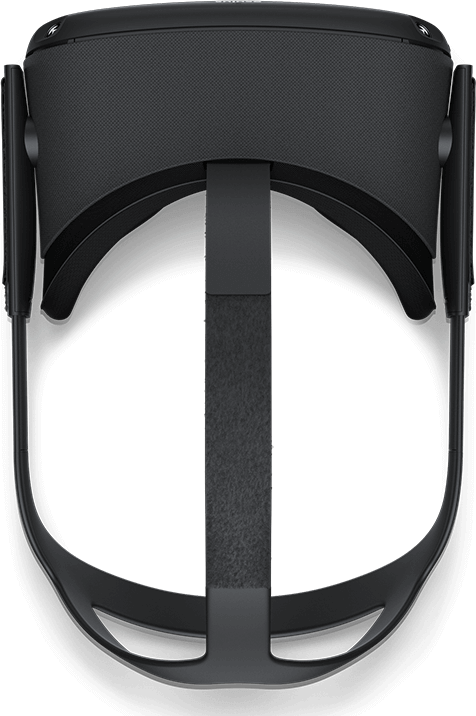
On the bottom of the headset is a volume control rocker switch to change the audio level. Beside that is the IPD slider which lets you adjust your display distance.
On the top of the headset is the power button on one side and the USB-C charging port on the other side.
Touch Controllers
The headset comes with two second generation Oculus Touch Controllers. They have been upgraded over the first generation controllers from the original Rift CV1 with a more comfortable design.
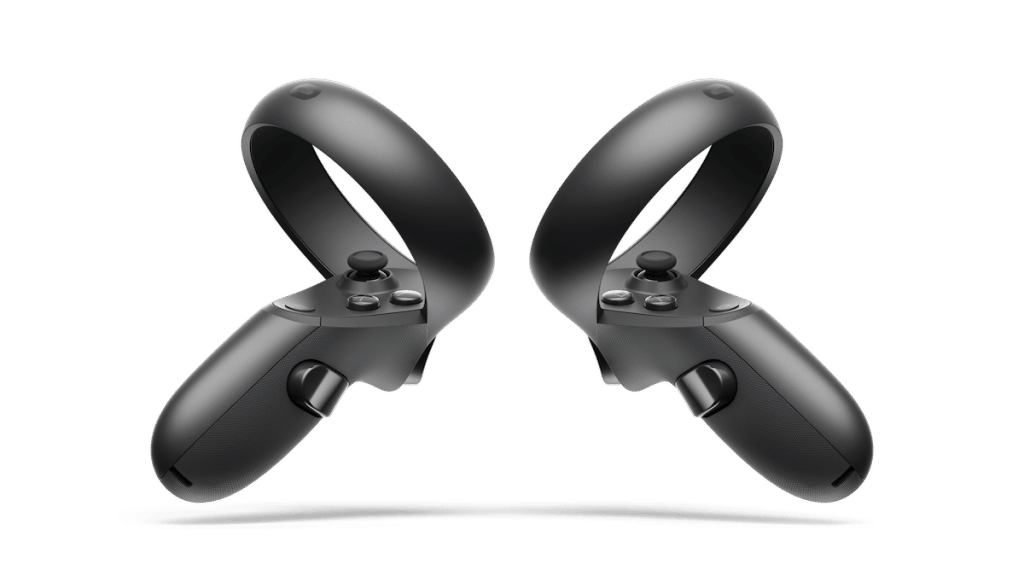
The motion controllers have a halo called a tracking ring which emits infrared light for the inside-out headset to track easily in space.
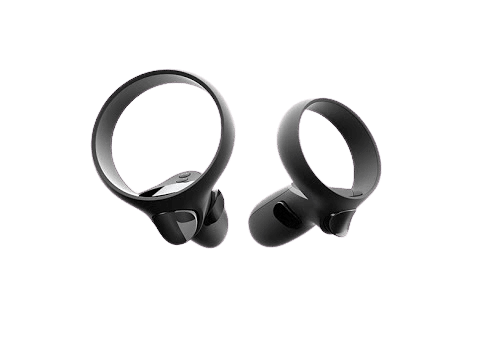
The controllers have top x and y buttons, a top analog stick, a back index finger button and back middle finger button. There is also an Oculus button on each controller which is used to bring up menus for the game and for the oeprating system.
Each controller is powered by a single AA battery.
Charging Cable
The Oculus Quest includes a USB-C to USB-C charging cable and an 15W wall adapter in the box. The charging cable is 10 feet long.
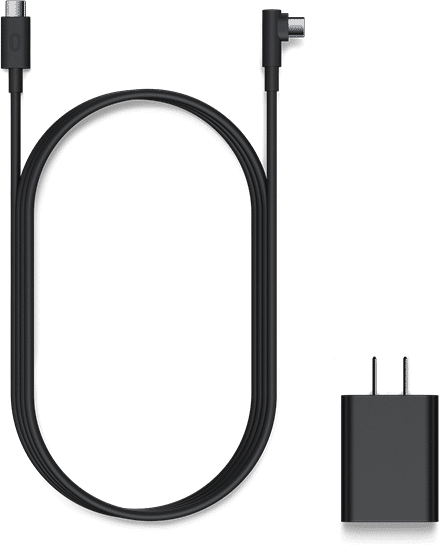
The USB-C end that plugs into the headset while charging has a 90 degree end on it.
Glasses Spacer
Included in the box is a glasses spacer to extend the foam padding by a few centimeters of extra space. This will prevent your glasses frames from bumping up against the lenses and scratching them.
Display
The Quest features a dual OLED Pentile display. OLED stands for organic light-emitting diode and is created by placing thin film in between two conductors. When you apply electrical current to it, OLED displays emit a bright light.
OLED requires low power to operate and does not require any backlighting.
Pentile is a family of patented subpixel matrix schemes used in electronic device displays. This technology helps to enlarge the sweet spot of each display lense.
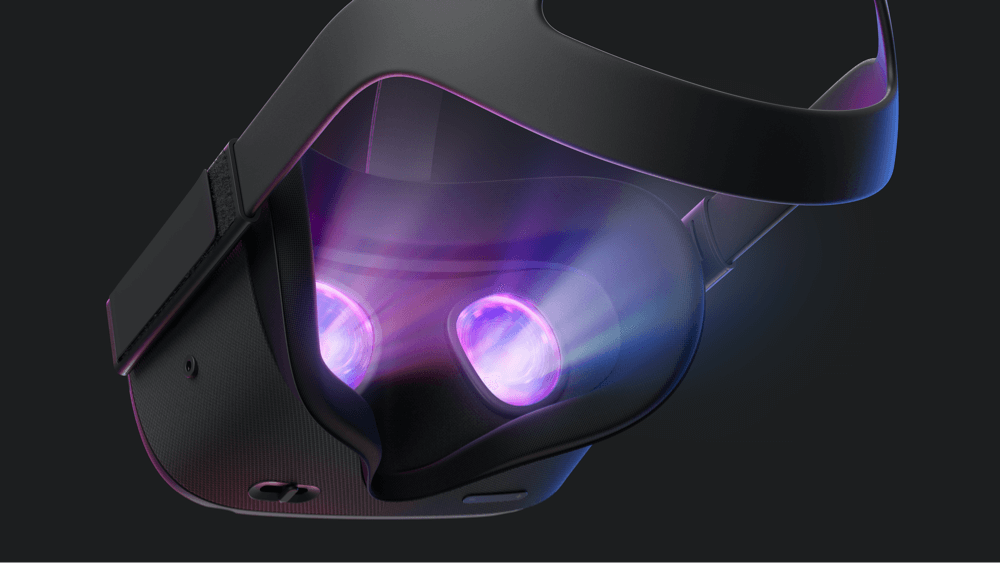
Resolution
The resolution of the headset is 1440×1600 per eye.
The refresh rate on the Quest is 72 Hz, which is slightly less than the 80 Hz on the Rift S. The decrease in refresh rate is to lengthen the battery life of the headset (see below).
The Field of View (FOV) on the display is 95 degrees.
Reduced Screen Door Effect
The “screen door” effect on the device has been reduced compared to original headsets. There is slightly more screen door on the Quest over other headsets. This is due to the OLED screen instead of LCD, which has more unlit space between each pixel.
Screen door is the effect of black empty space in between pixels which create the illusion that you are looking through a mesh screen door.

Less God Rays
The Pentile OLED display has less lens glare and god rays, caused by high contrast differences in colors.

Sensors
The headset is equipped with an Oculus VR sensor that contains an accelerometer, gyroscope, and magnetometer.
The gyroscope reports the rate of rotation along the X, Y, and X axis. This is used to track head position. The accelerometer tracks the speed and motion of the device. The magnetometer corrects error in the headset by using the earth’s known magnetic field.
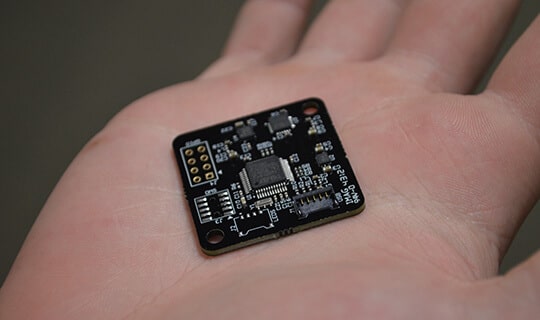
As a whole, the VR sensor communicates the Rift’s position, orientation, motion, speed, and other variables.
CPU
The Oculus Quest contains a Qualcomm Snapdragon 835 processor. This is the same processor used in the Samsung Galaxy S8, Google Pixel 2, OnePlus 5, and other similarly aged phones. The 835 has four performance Kryo 280 cores running at up to 2.45 GHz K and four efficiency Kryo 280 cores running at up to 1.9 GHz.

Hard Drive
The headset comes in two different storage options: 64 GB and 128 GB. The bigger size costs an extra $100.
Oculus Insight Tracking
The Oculus Quest includes inside-out headset tracking, which Oculus calls Insight Tracking. This is different than the original Oculus Rift CV1, which included an external sensor for outside-in.
4 cameras located on the four corners of the exterior of the headset point outward and keep track of your location in space and motion. When you put the device on your head, you’ll be asked to setup a guardian system, which is a safe boundary of play space around you. A safe space of 6.5 x 6.5 feet (42.25 square feet) is recommended.
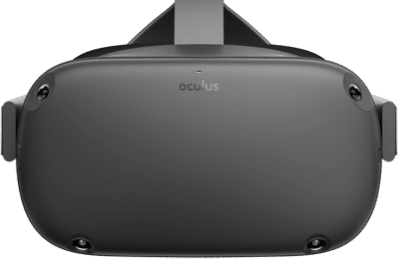
Software uses information in the VR sensor located in the headset and controllers to track movement. It’s software uses artificial intelligence (AI) to predict where the controllers are when it is outside the cameras’ field of view.
The Oculus Quest also includes a new passthrough feature, which allows you to view the real world outside of your headset via the front cameras. This allows you to see your living room without taking your headset off.
Battery Life
The Quest provides between 2 to 3 hours of battery life as advertised. It takes about 2 hours to charge the VR headset back up from completely dead.
You can plug the 6-foot charging cable in and play while the headset is charging.
Oculus Link
Oculus Link allows you connect your headset to an attached gaming PC in order to play any PCVR game available in the Oculus Rift or SteamVR stores. When you enable Oculus Link, the Quest is only used for its display and all computing power comes from the PC.
We have a full Oculus Link setup guide for the Oculus Quest, which explains the entire process.
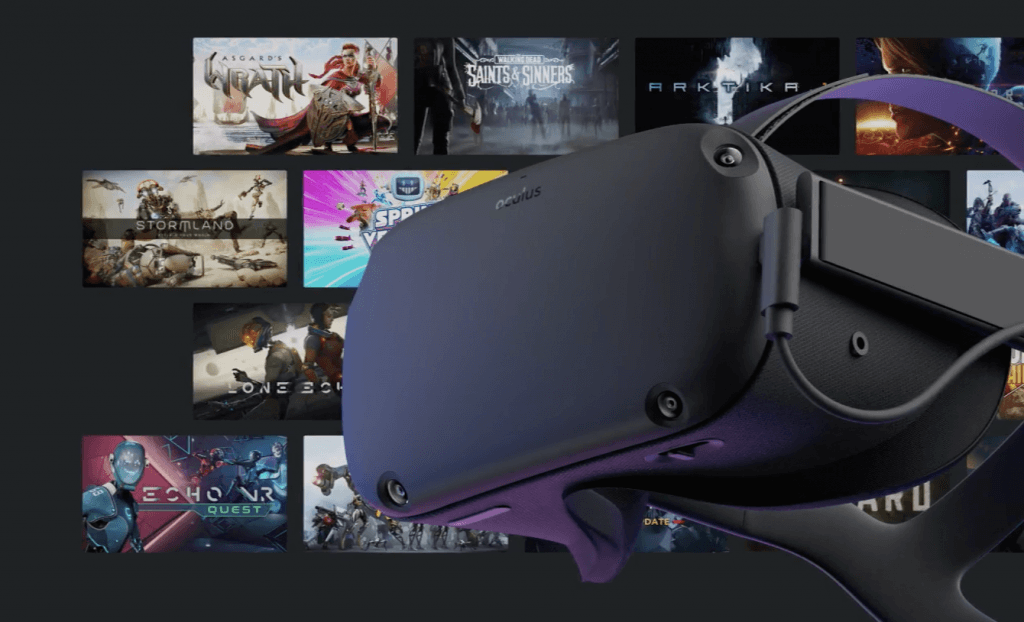
IPD
The Oculus Quest features an adjustable inter-pupillary distance between 58 – 72 mm. A dial on the bottom of the headset allows you to adjust the distance of the lenses in real-time.
Audio
There is integrated positional audio on the headset, which plays audio in the immediate area around you. the speakers are located right before the side strap begins.
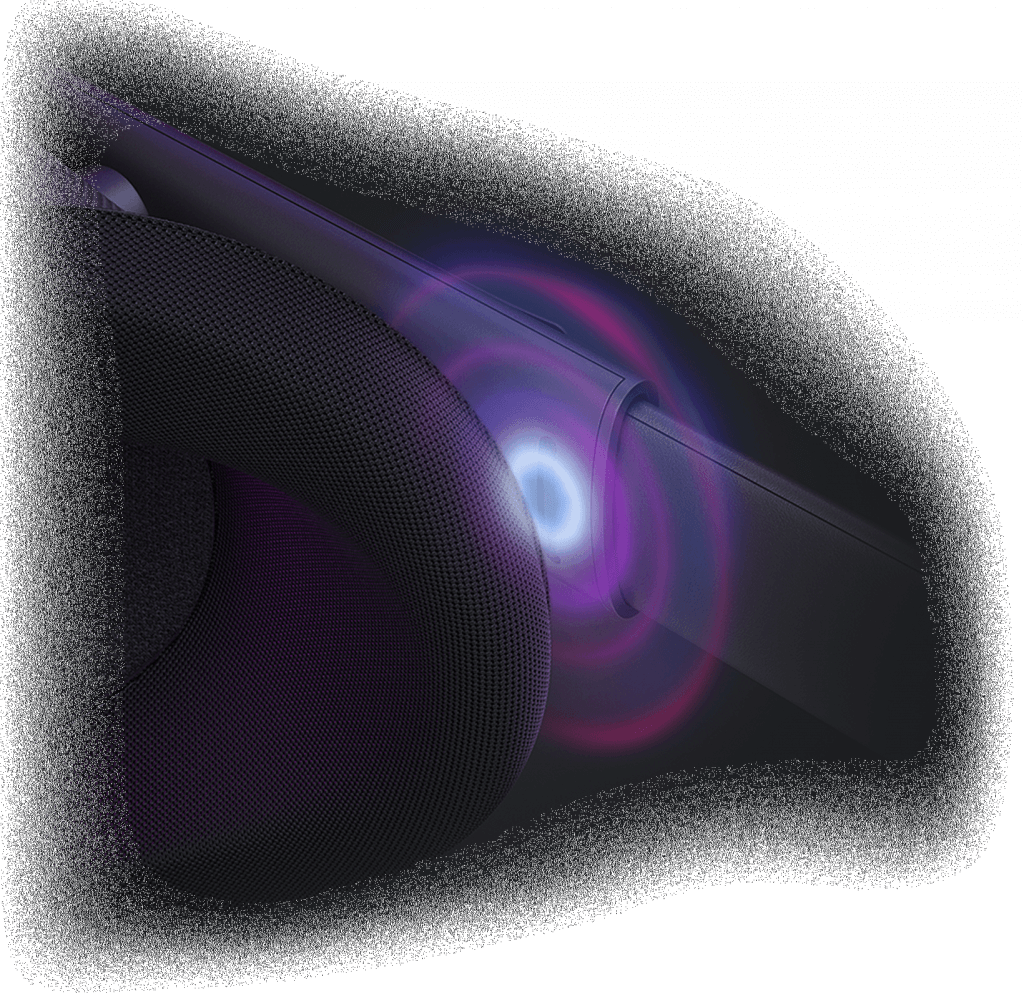
There is a headphone jack on the side which adds support for basic and more advanced headphones. This allows you to add on your own on-ear or in-ear headphones. Oculus sells their official in-ear headphones on the official website for $50.
Weight
The weight of the Quest 561g, about 20% more than the 470g of the original Oculus headset.
The additional weight is due to all of the extra components that are inside the Quest to make it a standalone headset: CPU, storage, and memory. The general consensus is that the heavier weight makes the headset less comfortable to wear, but is not a deal-breaker.
The weight distribution of the Quest is more towards the front of the headset than other hardware. This is known to cause “VR eyes”, or “raccoon eyes” after long periods of wearing the headset.
Games
Games are found by default in the Oculus Home store. Oculus Home is a mobile app that must be installed on your phone in order to configure the VR headset.
All games are installed directly on to the headset, which runs a modified Android operating system.

Originally, the device launched with 50 games, including Beat Saber, Sports Scramble, Angry Birds VR and others. Today, there are over 500 VR games located on the Oculus Home platform.
There are games with cross-play support, which means that you can buy the Rift or Quest version and get access to both copies of the game. This is useful if there is a deal on a game in one store.
SideQuest
There is a third-party app store for Quest called SideQuest. This is a spot for independent and professional VR developers to host and advertise their game for others to play. Oculus is known to have strict guidelines that have to be met in order to host a game in the official Oculus store. SideQuest is the free alternative to this restriction.

Today, SideQuest contains over 500 third party games. Games from SideQuest can be side-loaded onto any Quest headset.
Other Android APK files can also be installed on the headset. If they are not VR-compatible, you can play these games in 2D mode with a connected Bluetooth controller.
Sideloading
Games can be sideloaded from any ADB interface, which includes SideQuest and adbLink. You can also sideload game modifications to the Quest, such as custom songs for Beat Saber.
Price
The VR headset retails for $399 USD. This is the same price as the original Oculus Rift S headset. It is widely known that Oculus sells its hardware at a discounted price in order to get virtual reality into the hands of more people. The company makes their revenue back from their share of each game sold.
By comparison, the MSRP of the Valve Index is $499, HP Reverb G2 is $599, and the HTC Vive Pro is $799.
Accessories
Oculus sells a number of replacement accessories for the Quest on their official website. The list of accessories available are:
- Oculus Link Headset Cable
- Travel Case
- In-Ear Headphones
- Standard Face Cover
- 15W USB-C Power Adapter
- Left Hand Controller
- Right Hand Controller
In addition, Oculus sells VirtuClear lens inserts for those with a prescription for eye glasses.
Oculus Quest vs. Oculus Rift S
The following table below compares the Quest with the Rift S headset.
| Rift S | Quest | |
|---|---|---|
| IPD | Fixed 64mm | Variable 58-72mm |
| Sensors | Accelerometer Gyroscope Magnetometer | Accelerometer Gyroscope Magnetometer |
| Tracking | 6 degrees of freedom (DoF) inside-out tracking 5 camera sensors | 6 degrees of freedom (DoF) outside-in tracking 4 camera sensors |
| Mixed Reality | Passthrough+ | Passthrough+ |
| Cable | Single cable connection between headset and computer | None Required |
| Cable Connectivity | DisplayPort 1.2, USB 3.0 (5-meter) | N/A |
| Controllers | Oculus Touch second generation with 360-degree tracking support | Oculus Touch second generation with 360-degree tracking support |
| PC Requirements | See above | None |
| Weight | 561g | 561g |
| Release Date | May 21, 2019 | May 21, 2019 |
| MSRP Price | $399 | $399 (64 GB) or $499 (128 GB) |
We have a full in-depth Oculus Rift S vs Oculus Quest guide to check out for more details.

